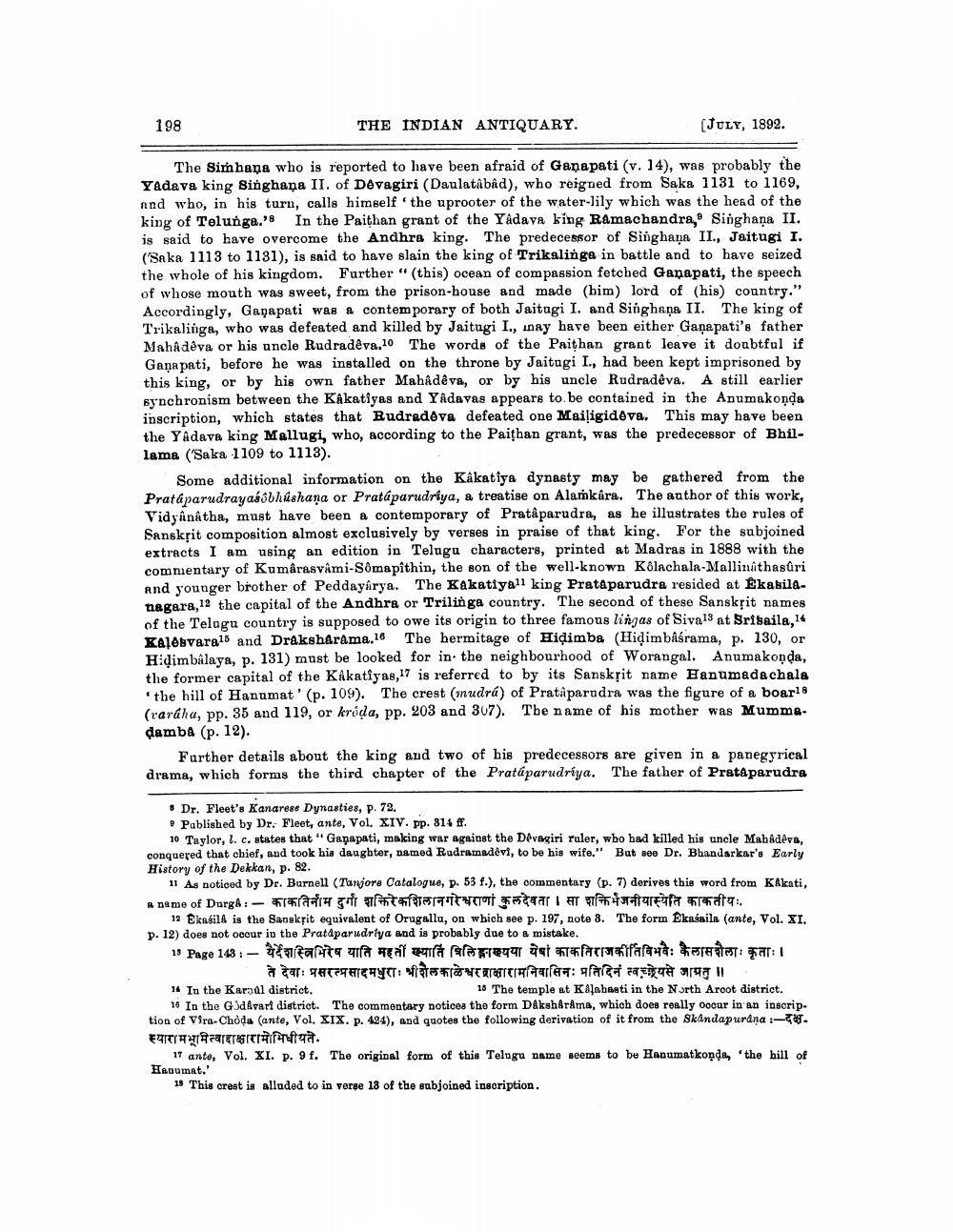________________
198
THE INDIAN ANTIQUARY.
(JULY, 1892.
The Simhana who is reported to have been afraid of Ganapati (v. 14), was probably the Yadava king Singhaņa II. of Devagiri (Daulatâbâd), who reigned from Saka 1131 to 1169, and who, in his turn, calls himself 'the uprooter of the water-lily which was the head of the king of Telunga.'8 In the Paithan grant of the Yadava king Ramachandra, Singhana II. is said to have overcome the Andhra king. The predecessor of Singhaņa II., Jaitugi I. (Saka 1113 to 1131), is said to have slain the king of Trikalinga in battle and to have seized the whole of his kingdom. Further" (this) ocean of compassion fetched Ganapati, the speech of whose mouth was gweet, from the prison-house and made him) lord of (his) country." Accordingly, Ganapati was a contemporary of both Jaitagi I. and Singhaņa II. The king of Trikalinga, who was defeated and killed by Jaitugi I., nay have been either Gaņa pati's father Mahadeva or his uncle Rudradêva.10 The words of the Paithan grant leave it doubtful if Gana pati, before he was installed on the throne by Jaitugi I., had been kept imprisoned by this king, or by his own father Mahadeva, or by his uncle Rudradêva. A still earlier synchronism between the Kakatiyas and Yâdavas appears to be contained in the Anumakonda inscription, which states that Rudradeva defeated one Mailigidêva. This may have been the Yadava king Mallugi, who, according to the Paithan grant, was the predecessor of Bhillama ("Saka 1109 to 1113).
Some additional information on the Kakatiya dynasty may be gathered from the Pratáparudrayaásbhushana or Pratáparudriya, a treatise on Alamkâra. The author of this work, Vidyanatha, must have been a contemporary of Pratâparudra, as he illustrates the rules of Sanskrit composition almost exclusively by verses in praise of that king. For the subjoined extracts I am using an edition in Telugu characters, printed at Madras in 1888 with the commentary of Kumârasvámi-Sômapithin, the son of the well-known Klachala-Mallinathasuri and younger brother of Peddayêrya. The Kakatiyall king Prataparudra resided at Ekabilanagara,12 the capital of the Andhra or Trilinga country. The second of these Sanskrit names of the Telugu country is supposed to owe its origin to three famous lingas of Sivals at Srisaila, 14 Kalebvarals and Draksharama.16 The hermitage of Hidimba (HidimbAsrama, p. 130, or Hidimbalaya, p. 131) must be looked for in the neighbourhood of Worangal. Anumakonda, the former capital of the Kakatiyas,17 is referred to by its Sanskrit name Hanumadachala *the hill of Hanumat' (p. 109). The crest (mudrá) of Pratîparudra was the figure of a boar18 (raráha, pp. 35 and 119, or króda, pp. 203 and 307). The name of his mother was Mumma. damba (p. 12).
Farther details about the king and two of his predecessors are given in a panegyrical drama, which forms the third chapter of the Pratáparudriya. The father of Prataparudra
Dr. Fleet's Kanarese Dynasties, p. 72. Published by Dr. Fleet, ante, Vol. XIV. pp. 314 ff.
10 Taylor, l. c. states that "Gapapati, making war against the Devagiri ruler, who had killed his uncle Mahadeva, conquered that chief, and took his daughter, named Rudramadevi, to be his wife." But 300 Dr. Bhandarkar's Early History of the Dekkan, p. 82.
11 As noticed by Dr. Burnell (Tanjore Catalogue, p. 53 f.), the commentary (p. 7) derives this word from KAkati, A name of Durga : - Fararh gor TTTTTTTTTATI AT E
07:. 12 EkasilA is the Sanskrit equivalent of Orugallu, on which see p. 197, note 8. The form kasaila (ante, Vol. XI. p. 12) does not occur in the Pratdparudriya and is probably due to a mistake. 18 Page 143 : - fantaa Feat via les Fietar dat amefariwarang:
: 1 ageTECHYTT: paranterarfer: grau 14 In the Karnal district.
10 The temple at Kalahasti in the North Aroot district. 16 In the G3dkvart district. The commentary notices the form DAksharama, which does really occur in an inscription of Vira-Chồda (ante, Vol. XIX. p. 424), and quotes the following derivation of it from the Skandapurana :स्यारामभामित्वादाक्षारामोभिधीयते.
17 ante. Vol. XI. p. 9 f. The original form of this Telugu name seems to be Hanumatkonda, 'the hill of Heumat.
15 This crest is alluded to in verse 13 of the subjoined inscription.




